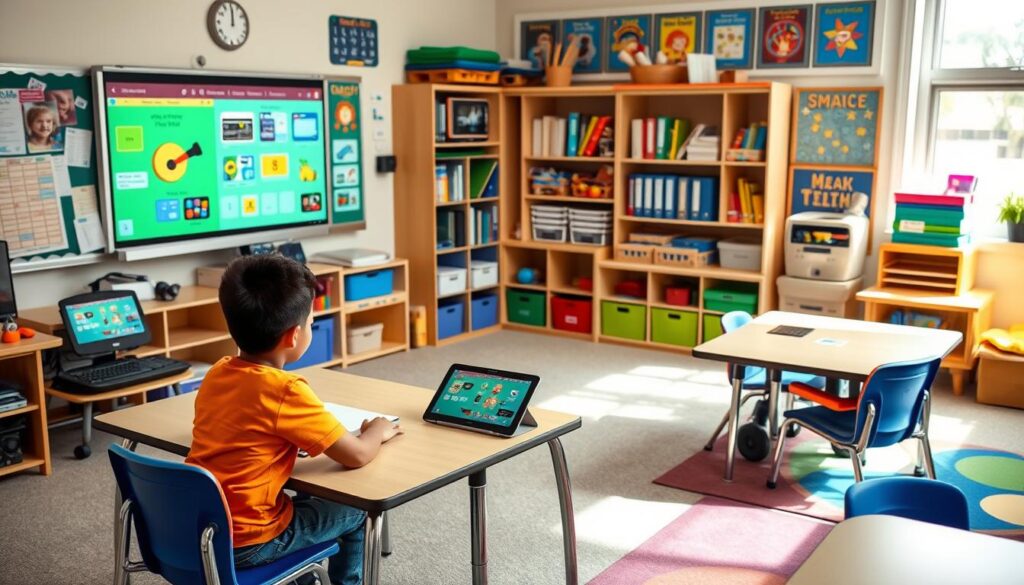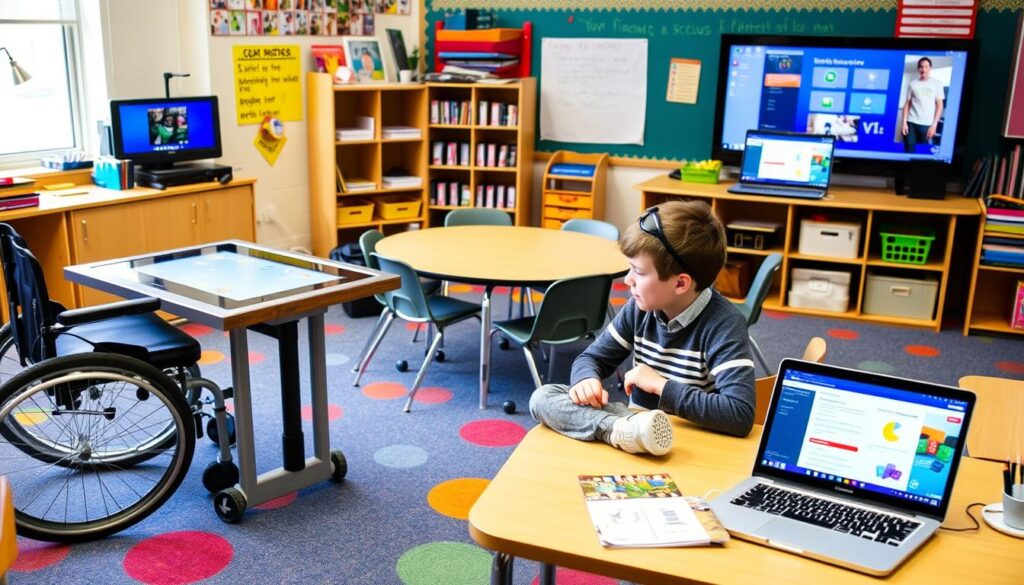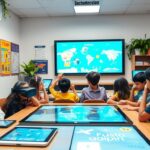Did you know about 14% of public school students in the U.S. get special education? This shows how vital assistive technology for students with disabilities. It helps them do well in school. Assistive technology includes many tools and services for different needs.
From wheelchair ramps to text-to-speech software, these tools are key educational aids for special needs students. They make learning better and help students be more independent.
Under the Individuals with Disabilities Education Act (IDEA), assistive technology is defined. It helps with different learning needs and reduces barriers in school. By using accessibility technology for students, teachers can make classrooms more inclusive. Every student will have an equal opportunity to succeed in this way.
When used right, assistive technology can really help students do better in school. It boosts their confidence and helps them achieve more.
Key Takeaways
- Assistive technology is very important for students with disabilities.
- It includes many tools, like voice-activated computers and large-print books.
- Schools must offer assistive technology as part of special education services.
- Using it well can greatly improve students’ grades and independence.
- Funding for assistive technology can come from schools and private insurance.
Introduction to Assistive Technology
Assistive technology is key for students with special needs in school. Laws like the Technology Related Assistance Act of 1988 and the Assistive Technology Act of 1998 make it more important. The Individuals With Disabilities Education Act (IDEA, 2004) requires schools to make technology accessible for all.
An assistive technology device helps a child with a disability. It can be simple, like adapted utensils, or complex, like speech-to-text software. Schools must find the right tools, customize them, and teach students how to use them.
Assistive technology lets students join in classroom activities they couldn’t before. For example, visual aids help with reading, and mobility devices open up physical spaces. Each student gets a device that fits their needs, making learning inclusive for everyone.

What is Assistive Technology?
Assistive technology is key in helping students with disabilities learn better. It includes devices, software, and systems that help people with disabilities. The main goal is to help students learn and be independent.
Definition and Purpose
Assistive technology is very important in schools. It can be high-tech, like special software, or low-tech, like pencil grips. It helps students with different disabilities, like autism and mobility issues.
Its purpose is to make learning easier for everyone. It helps create a welcoming place for all students.
Types of Assistive Technology Devices
There are many assistive technology devices out there. They help make schools more inclusive. Here are some examples:
- Mobility Aids: Includes wheelchairs and walkers, enhancing physical movement.
- Communication Devices: Speech-generating devices and apps that assist in expressing thoughts.
- Text-to-Speech Software: Converts written text into audible speech, benefiting students with reading difficulties.
- Adaptive Writing Tools: Specially designed pens and grips that facilitate writing for those with limited dexterity.
- Visual Aids: Tools like magnifiers and Braille displays that support students with visual impairments.
Going to events like the ATIA Conference is great for learning about these tools. It’s a chance to learn from experts and see new devices. It’s also a place to meet others who care about assistive technology.
| Type of Assistive Technology | Primary Function | Examples |
|---|---|---|
| Mobility Aids | Enhancing physical movement | Wheelchairs, walkers |
| Communication Devices | Facilitating communication | Speech-generating devices, text-based apps |
| Text-to-Speech Software | Assisting with reading | Read&Write, Voice Dream Reader |
| Adaptive Writing Tools | Supporting writing tasks | Ergonomic grips, slant boards |
| Visual Aids | Enhancing visual perception | Magnifiers, Braille displays |

Importance of Assistive Technology in Education
Assistive technology is very important in schools. It helps students with disabilities get the same learning chances as others. This technology helps students with dyslexia, autism, and ADHD to do well in school.
Students with disabilities learn more effectively thanks to assistive technologies. For example, devices that help with communication let students share their thoughts in class. This makes the classroom a place where everyone feels included and understood.
It also helps students learn on their own, without always needing a teacher. Tools like text-to-speech software and speech recognition software make learning personal. They help students with different needs find new ways to read and write.
Using assistive technology in schools has many benefits. It helps students with disabilities do better in school. It also prepares them for success after school. Schools should let students try out different tools to find what works best for them.
| Assistive Technology Type | Function | Benefits |
|---|---|---|
| Text-to-Speech Software | Converts written text into spoken words. | Supports students with reading difficulties. |
| Speech Recognition Software | Transcribes spoken words into written text. | Aids students with motor skill challenges to articulate their thoughts. |
| AAC Devices | Uses symbols and pictures for communication. | Enhances expression for nonverbal students. |
| Interactive Whiteboards | Engages students visually and tactilely. | Facilitates collaboration and teamwork. |
Assistive Technology for Students with Disabilities
Assistive technology is key in making learning better for students with disabilities. It helps all learners take part in classroom activities. This part talks about devices for different needs and how software helps in learning.
Types of Assistive Devices for Different Disabilities
Choosing the right assistive devices is important. Here are some common ones:
- Screen Readers: For students who can’t see well, these turn digital content into sound.
- Text-to-Speech Software: Programs like Speechify help those with ADHD and dyslexia by reading text out loud.
- Refreshable Braille Displays: These devices let blind users feel digital text.
- Eye-Tracking Devices: Tobii technology lets students with limited motor skills control computers with their eyes.
- Adaptive Keyboards: Custom keyboards help students with physical and cognitive challenges.
The Role of Assistive Software in Learning
Learning software is a big help for students with special needs. Programs like Kurzweil 3000 offer text-to-speech and speech-to-text, great for those with learning disabilities. Google Classroom also helps with executive function, making complex tasks easier.
There are also new tools for disabilities, like adaptive technology. For example:
| Assistive Software | Target Group | Key Features |
|---|---|---|
| Speechify | ADHD, Dyslexia | Text-to-audio conversion |
| Kurzweil 3000 | Vision Impairments, ADHD | Text-to-speech, Speech-to-text |
| Tobii Eye-Tracking | Limited Motor Skills | Gaze-based computer control |
| KNFB Reader | Blind, Low-Vision | Text-to-audio, Braille conversion |
Using these technologies helps students learn in their own way. It makes learning fair for everyone. These tools help students face challenges and get the education they deserve.
Understanding Special Education Requirements
To use assistive technology in schools, I need to know the special education rules. The Individuals with Disabilities Education Act (IDEA) says students with disabilities must get a Free Appropriate Public Education (FAPE). This law helps create plans that meet each student’s needs.
The IEP process is key in figuring out what assistive technology a student needs. For instance, a student’s IEP or 504 plan lists the assistive technology they need. This can include tools like screen readers and adaptive keyboards for students with learning disabilities. About 1 in 59 kids have a learning disability, making these plans very important.
I also need to understand what schools must do with assistive technology. The Department of Education gives schools about 60 days to assess a child after getting consent. After the assessment, the school staff provides ongoing support and training for using the technology.
Schools must also take care of the assistive technology listed in IEPs. If the devices belong to the Department of Education, they must be returned when a student graduates or moves to another school. This helps ensure all students have access to the resources they need in an inclusive learning environment.
How to Obtain Assistive Technology
Getting assistive technology means following certain steps. These steps help make sure it fits into a child’s school plan. It’s about finding the right tools for their education.
Integrating Assistive Technology into the IEP Process
The first step is to understand what challenges the child faces. Knowing these challenges helps find the right technology. When I share my concerns, experts can see how the technology works in class.
Evaluations might include simple tools or advanced apps. This helps find the best fit for the student.
After the evaluation, the IEP Team suggests devices and services. This team effort makes sure the technology is good for the student. Assistive technology helps kids do more and be more independent.
It’s key to train both the child and the teachers. Regular updates keep the technology working well. Checking it every year ensures it still meets the child’s needs.
Funding Sources for Assistive Technology
Getting funding for assistive technology is key for students with disabilities. There are many sources, like school district support and private insurance. Knowing these options helps families find the right financial help for their child.
School Districts and Private Insurance
School districts are big helpers in funding assistive technology. The Individuals with Disabilities Education Act (IDEA) Part B helps by covering AT costs if it’s in a child’s IEP. Part C also offers free AT if it’s in a child’s IFSP. Working with teachers is important to make sure AT is included in these plans.
Private insurance can also help get the devices and services needed. Many policies cover AT if a doctor prescribes it. It’s important for families to know what their insurance covers and what they might have to pay for. Also, remember that parents shouldn’t have to pay for assistive technology, as stated by the Office of Special Education Programs (OSEP).
Medicaid and Public Benefits
Medicaid is another important source for funding assistive technology. It covers AT services and equipment that are medically necessary. The Early and Periodic Screening, Diagnosis, and Treatment (EPSDT) program under Medicaid also helps by covering more services. Families should check if they qualify and understand the application process.
Many states offer low-interest loans for AT through state Assistive Technology programs. Groups like Lions, Sertoma, and United Way might also provide funding. Schools should help families find these resources, like the UCP Bellows Fund and local AT reuse programs.
Examples of Popular Assistive Technologies in the Classroom
In today’s classrooms, using assistive technologies is key for students with disabilities. These tools make learning easier and help students feel more confident. We’ll look at three main types: text-to-speech software, adaptive writing tools, and eye-tracking devices.
Text-to-Speech Software
Tools like Speechify and Kurzweil 3000 are crucial for students with reading challenges. They turn written text into spoken words. This helps students with dyslexia or other reading issues.
These tools let students listen to text while reading. It helps them understand and remember better. It makes learning more accessible and inclusive for everyone.
Adaptive Writing Tools
Adaptive writing tech is vital for students who struggle with writing. Software like Co:Writer guesses words as you write. Dragon Naturally Speaking lets you write by speaking.
These tools improve writing skills and boost confidence. They make learning more engaging and fun for students.
Eye-Tracking Devices
Eye-tracking tech is a big help for students with severe disabilities. Devices like Tobii Dynavox let users control computers with their eyes. It completely changes the way they learn.
These devices help students interact and express themselves. They open up new ways for students to engage in their education.
Challenges and Barriers in Accessing Assistive Technology
Assistive technology (AT) has many benefits, but it’s hard for students to get it. Funding issues, lack of teacher training, and not knowing about AT are big problems. Studies show that only a small percentage of people with disabilities in southern Africa have access to AT.
I looked at 19 journal articles about AT challenges in Africa. The research mostly came from South Africa. Users face many barriers, like buildings that are hard to get into and no braille services.
Money is a big problem too. Rural areas often can’t afford the services and training needed for AT. This makes it hard for people to get and use the devices they need.
But, there are some good signs. AT is becoming more common in schools. Now, even regular devices have features like text-to-speech software. This helps students with hearing problems, showing that solutions do exist.
To make sure everyone can use AT, we need to tackle these big challenges. It’s crucial to create a place where students can use technology to learn better, without facing too many obstacles.
| Barrier Type | Description | Impact on Access to AT |
|---|---|---|
| Financial Constraints | Limited budget for purchasing assistive technology | Restricts access to necessary devices, especially in rural areas |
| Lack of Training | Insufficient training for educators and technical staff | Hinders proper implementation and use of available assistive technology |
| Environmental Barriers | Inaccessible buildings, lack of elevators and braille | Prevents individuals from utilizing assistive technologies effectively |
| Awareness Issues | Limited understanding of available assistive technology options | Reduces student and family engagement in accessing AT resources |
Future Trends in Assistive Technology for Students
Assistive technology is changing fast, bringing new hopes for students with disabilities. Artificial intelligence is leading this change. It’s making learning more personal and accessible for everyone.
The Role of AI in Educational Assistive Technology
AI is bringing new tools to assistive technology. These tools are changing how we learn and interact. Here are some examples:
- Predictive technologies adjust learning materials for each student, making learning more engaging.
- Smart prosthetics help students move better, showing AI’s real-world impact.
- Speech recognition software helps students by turning speech into text, even in noisy places.
Tools like MouthPad are making communication easier for students with mobility issues. It’s a big step forward for education, especially for students with special needs.
Mobile technology is also changing education. Apps and voice assistants are making learning easier for all. Students can learn anywhere, anytime.
There’s a growing focus on making technology inclusive. Companies are working with people with disabilities to create better tools. Virtual and augmented reality will soon offer immersive learning experiences for everyone.
In summary, assistive technology has a promising future. AI is making learning more personal and accessible. This shift towards inclusivity is exciting and promising for education.
Supporting Schools and Educators with Assistive Technology
Helping schools use assistive technology well means giving teachers the right support. Training on assistive technology helps teachers know how to use these tools. About 28% of students with disabilities use these tools in school, showing how important it is for teachers to know how to help.
Training Teachers and Staff
Teachers need training to work well with students who need assistive technology. There are many training programs for this. These programs teach:
- Understanding different types of assistive technology devices and software.
- Learning how to assess students’ individual needs for using assistive technology.
- Implementing these tools effectively within the classroom environment.
- Monitoring and evaluating the impact of assistive technology on student learning outcomes.
When teachers get trained, they can help students more. Students using assistive technology show a 20% increase in independence. This shows how assistive technology can really help students succeed.
When teachers learn to use assistive technology, they help students with disabilities learn better. Training programs help students and make classrooms more inclusive. Everyone feels appreciated and respected as a result.
Conclusion
Assistive technology is key for an inclusive education for students with disabilities. This article has shown many tools, from writing aids to communication devices. These tools greatly improve learning. But, access to them varies a lot.
Access depends on where you live, your family’s income, and your education level. This is a big issue.
Thinking about accessibility, we see the need for training, funding, and support. Without these, students might struggle, especially when moving to independent living or work. The lack of access to these tools in different places is a big problem.
We need to keep working towards inclusive education. I hope to inspire teachers, families, and leaders to use assistive technology. By doing this, we can make sure all students get the chance to succeed.
FAQ
What is assistive technology for students with disabilities?
Assistive technology helps students with disabilities. It includes devices, software, and systems. Learning is made simpler and more accessible by these resources.
How can assistive technology improve learning experiences?
It makes learning better by helping students overcome challenges. This leads to better grades, communication, and social skills.
What types of assistive devices are commonly used in educational settings?
Schools use many assistive devices. These consist of writing instruments, mobility aids, and communication tools. There are also software apps for reading and writing.
What role do Individualized Education Programs (IEPs) play in obtaining assistive technology?
IEPs outline what students need. They ensure schools provide the right support and tools.
How can families secure funding for assistive technology?
Families can get help from schools, insurance, and Medicaid. They need to work with schools and service providers.
What challenges do families face in accessing assistive technology?
Families face many challenges. These include not enough money, lack of teacher training, and hard-to-get technology.
How is artificial intelligence (AI) influencing assistive technology?
AI makes learning more personal. It makes things more accessible and adapts to each student’s needs.
What types of assistive software are beneficial for students?
Good software includes tools for reading and writing. It also includes educational apps that help different learning styles.
How important is training for educators in using assistive technology?
Training is key. It helps teachers use technology well. This supports students with disabilities in reaching their goals.
Can you provide examples of specific assistive technologies currently used in classrooms?
Yes. Examples are Speechify and Kurzweil 3000 for reading. There’s also Co:Writer and Dragon for writing. Eye-tracking technology helps students with severe disabilities.



